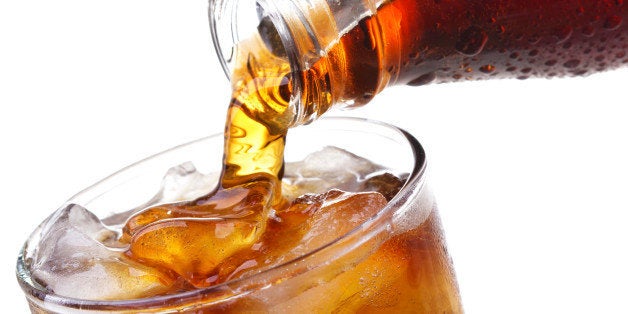
A study out last week in the top-tier journal Nature told us that non-caloric artificial sweeteners (NAS) may contribute to glucose intolerance by mucking up our microbiomes. That's a serious indictment, since these products are intended to help defend against glucose intolerance, and other ills related to diabetes risk and weight gain. After all, they are replacements for sugars that have already been comparably indicted.
The study, which received considerable media attention and may already have caught yours, was both elegant, and complicated. It was actually one paper, but a series of studies in both mice and people. Most of the work was in mice, where the introduction of NAS -- specifically saccharin, aspartame, or sucralose -- induced glucose intolerance. The underlying cause of this metabolic effect was traced to a marked change in the bacterial populations colonizing the GI tracts of the mice. The adverse effect was reversible with antibiotics that killed off the newly favored bacterial colonies.
Studies in humans suggested much the same, but these were less controlled, and conducted in very few people, with less consistent results. The translation of these findings from mice to people was generally supported.
While the human research was far from decisive, the takeaway from the constellation of studies was clear enough. Replacing sugar with artificial sweeteners may fail to facilitate the intended benefits. By compromising the ecology of the microbiome -- of both mouse and man -- the effect may be just the opposite.
The epidemiology is, for the most part, rather consistent with such unintended consequences. Diet soda has been linked to obesity, although questions are routinely raised about the direction of causality (i.e., maybe drinking diet soda makes people fat; maybe overweight people turn to diet soda to help control their weight). Associations have been established with serious chronic diseases as well, although again, both specific proof of causality and mechanism are lacking.
From my perspective, this new research, provocative though it may be, merely puts the icing on a well-baked cake. I think we had good reason to avoid artificial sweeteners before now.
In brief, we are right when in the vernacular we refer to a "sweet" tooth, rather than a "sugar" tooth. The taste preference we are referencing is, indeed, generic to all substances that trigger the recognition of "sweet" in the brain.
What we mean, of course, when we say "sweet tooth" is a preference for all things sweet. When the issue of food addiction is debated, the sensation that tops the list of likely candidates is sweet. If any response to food hardwired into our nervous systems rises to the level of addiction, it would be the response to sweet.
This means several things. First, a sweet tooth may be exploited to propagate our eating and profit from it. Put sweeteners into foods -- even foods not customarily thought of as sweet -- and the amount of eating we are apt to do before stopping increases. This is done, and the results are as predicted, entirely by profitable and exploitative design.
It also means that the more we get, the more we want, and need, to feel satisfied. In addiction, this is called tolerance. In the case of a sweet tooth, it means graduation to a sweet fang that pretty much takes over your kitchen, and your life.
There is every reason, residing in sense as well as science, to suspect that NAS contribute just as readily to this phenomenon as caloric sugars. The commonly used artificial sweeteners are intensely sweet, all much more so than sugar. The net result, then, is that while NAS might remove sugars and the associated calories at any given time, they would cultivate the sweet tooth that would favor their readmission at some other time. That's easily done, since there are popular brands of bread, crackers, chips, pretzels, salad dressings and pasta sauces with added sugar. One might favor such products due to a sweet tooth, and never even be aware of it.
What, then, is the answer? Neither the current excess of sugars, nor the sugar substitutes that foster a sweet tooth and disrupt the microbiome. There may be better options in the pipeline, namely non-caloric sweeteners that don't exert unintended harms. Both stevia and monk fruit extract look promising at this point, but we need more data.
In my opinion, the best answer is a method I call "taste-bud rehab," that allows for titrating down one's standard daily exposure to sweeteners quite painlessly, then acclimating to that ever lower level. Taste-bud rehab is one example of skillpower, willpower's oft-neglected cousin. Titrate down exposure to total sweeteners, come to prefer foods less sweet, and then use actual sugar -- but much less of it.
The nutritional sweet spot will never be reached courtesy of the prevailing excess of added sugars, whatever their formulations. We now have more cause than ever to think that it will not be facilitated by substituting non-caloric artificial sweeteners, either.
Science and sense have long suggested that the way to go was reducing the total amount of "sweet" in our diets, and rehabilitating our taste buds in the process. The result is not only a diet much lower in sugars and free of NAS, but a diet that you genuinely prefer that way. Add the relevant skillpower to science and sense, and you can get to the much-less-sweet sweet spot from here. When you do, you will find yourself loving food that loves you back -- from your mouth, to your microbiome.
And, I suppose, to your mice, too, if you happen to have any of those.
-fin
Author, Disease Proof (now available in paperback)
Co-parent, Cuisinicity.com (love the food that loves you back!)